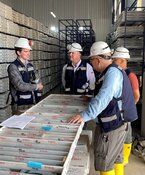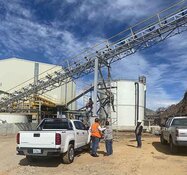In the late 1980s, during my tenure peddling securities with Midland-Walwyn Capital, I watched in amazement as a couple of ex-Gundy whiz-kids designed a product called the "Nikkei put warrants" and began marketing them as a new issue for clients and, of course, the firm's prop desk.
Japan had been on a global roll since the 1970's as emerging auto giants like Toyota and Honda were gouging enormous swaths of market share from the Big Three U.S. automakers while electronics fledglings Toshiba, Panasonic, and Sony were dumping massive quantities of state-of-the-art stereos and Walkman's into the North American marketplace with such astounding efficiencies that earnings for these companies grew to the sky.
It was once said that by 1990, a square block in downtown Tokyo was worth all of the real estate in the State of California. To say that a "bubble" was formed in the latter stages of the vertical incline in the Nikkei 225 index is an understatement of the highest order. In 1990, Japanese real estate developer Minoru Isutani bought the Pebble Beach Golf Links for $850 million, causing a shock wave around the world. Favored tourist destinations around the world were inundated with an entirely new demographic of wealthy Japanese travelers spending outrageous sums of money on souvenirs from exotic places only dreamed of a decade ago.
Then, as it occurs with all bubbles, it popped.
From Wikipedia:
- "The Japanese asset price bubble(バブル景気, baburu keiki, lit. 'bubble economy') was an economic bubble in Japan from 1986 to 1991 in which real estate and stock market prices were greatly inflated. In early 1992, this price bubble burst, and Japan's economy stagnated. The bubble was characterized by rapid acceleration of asset prices and overheated economic activity, as well as an uncontrolled money supply and credit expansion. More specifically, over-confidence and speculation regarding asset and stock prices were closely associated with excessive monetary easing policy at the time. Through the creation of economic policies that cultivated the marketability of assets, eased the access to credit, and encouraged speculation, the Japanese government started a prolonged and exacerbated Japanese asset price bubble."
For the better part of the past nine months, I have been cautioning my subscribers on the dangers of buying into the current "stocks are cheap" narrative being spewed out day in and day out by the financial media, whose only task is to maintain interest in the equity markets. After 45 years of trying valiantly to successfully navigate the tumultuous waters of the global stock and commodity markets, my advancing age has created an innate cynicism that wants to hurl inanimate objects at the TV screen every time I hear one of the CNBC "guest commentators" use the term "buying opportunity." I have never heard one of them use the term "selling opportunity" after an issue has had a particularly sharp advance.
If I had to describe the current state of the S&P 500 and the American economy, I would use a phrase from 1992 Japan. I would say the following: "<America is> characterized by the rapid acceleration of asset prices and overheated economic activity, as well as an uncontrolled money supply and credit expansion. More specifically, over-confidence and speculation regarding asset and stock prices were closely associated with excessive monetary easing policy at the time."

From 1992 until 2018, land prices in Japan stagnated in an era referred to as "The Lost Decade" as bank after bank had to be bailed out by the Bank of Japan. The Nikkei 225 index fell from just under 40,000 to under 10,000 by 2003 as the excesses of easy monetary policy and unbridled credit creation were slowly and agonizingly unwound, leaving hundreds of thousands of investors destitute but, more importantly, wary of Japanese stocks for nearly two decades.
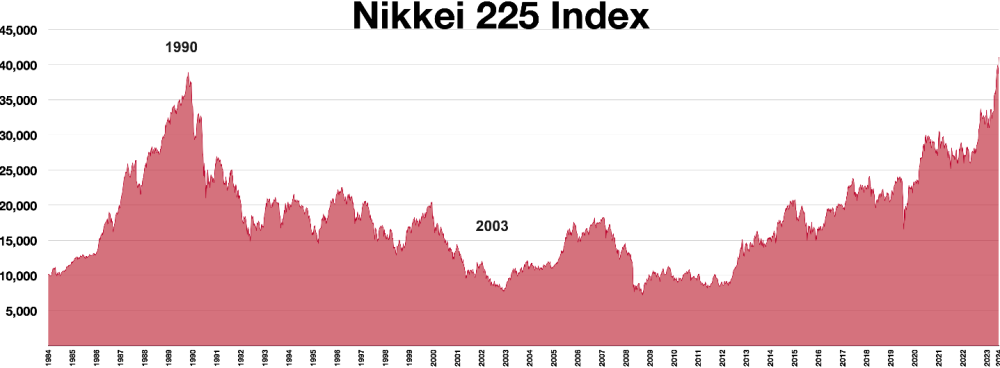
Back to the late-80's and the Nikkei put warrants. They were priced at $2.50 per warrant, and I placed an absolute pile of them with clients after listening to a seminar by a kitchen table financial planner expound on the virtues of owning "all things Japanese" as he trotted out every imaginable gadget and toy that was then the rage of the ADHD-afflicted youth of the day.
He showed the crowd a picture of his new Honda Civic and then another picture of his Kawasaki motorbike, urging everyone to buy the Japanese fund that had advanced over tenfold since 1970. It was the exact narrative to which I have been listening except instead of "all things Japan", in 2024 it is "all things artificial intelligence."
As much as Sony was priced for perfection in 1990, Nvidia Corp. (NVDA:NASDAQ) is priced for perfection in 2024 — or at least it was. Actually, the shares are now officially in bear market territory, down over 24% at the low of the week.
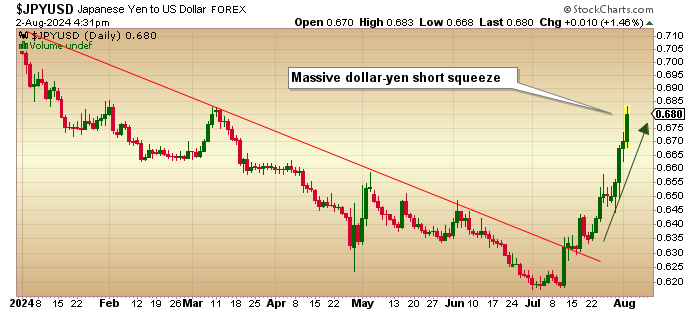
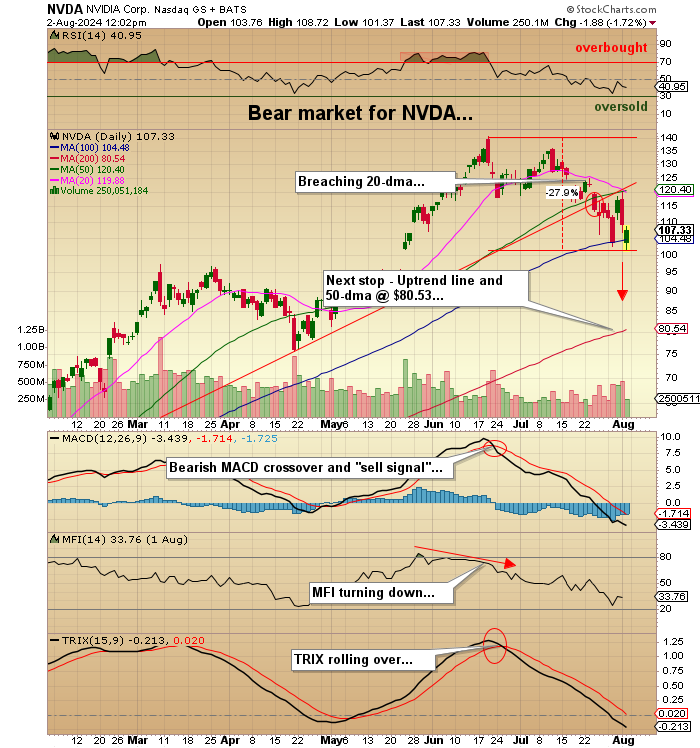
What triggered the late-week avalanche of panic selling was an unemployment report that sorely missed the Street consensus (175,000 new jobs) coming in at 114,000 as the lag effect of the 2023-2024 rate increases is finally impacting earnings and, more importantly, forward guidance. Unfortunately, that is not the problem with the economy or the stock market. The problem is that the steps taken by Japan to protect its capital markets involved artificially suppressing yields in a process called "yield curve control" ("YCC") that allowed hedge fund managers around the globe to borrow vast amounts of Yen, which was then used to collateralize purchases of "risk assets" including U.S. stocks and bonds.
That has been working wonderfully for decades as it allowed the indelicate application of massive leverage to the hedge fund portfolios of traders the world over, and as long as the Japanese Yen behaved itself and stayed relatively stable versus the U.S. greenback, life was rosy, especially with the American markets ripping higher.
Alas, under the headline "If it sounds too good to be true, it probably isn't," a funny thing happened on the way to the compliance office. The Yen went into a soaring ascent against the dollar and that meant that the hedge funds that were short Yen and long the dollar by way of risk assets in U.S. markets have been suddenly forced to cover their Yen shorts. That entails selling risk assets like the Mag Seven, to which they have been inextricably linked for the better part of the year.
This is called "the dollar-yen carry trade" and no one really knows just how deeply it is connected to the current U.S. equity bubble. One thing is for sure: the leverage applied to hedge fund portfolios works both ways. There is upside leverage, and there is downside leverage, and when all those under-margined hedgies start running for the exits en masse, that liquidity bragged about by CNBC commentators that will "always be present in the U.S. markets" suddenly went poof!
So, here we are. A minor little flick of a Zippo lighter called "the jobs report" has touched off a stock market brush fire, not unlike the ones they are battling in California or Alberta. I have been trading the Invesco QQQ ETF (QQQ:NASDAQ) put options on and off for the past two months, and every time I think the market is about to crash (which it should), another bid comes rolling in, and I have to stand back.
We are heading into August now, which is historically an "OK" month, but that leads to September, statistically the worst month of the year and particularly hazardous in an election year, which this most certainly is. I take one look at the NASDAQ and the S&P, and I think "Japan 1990." Being long, a few put options seems like a pretty good idea. . .
Gold and Silver
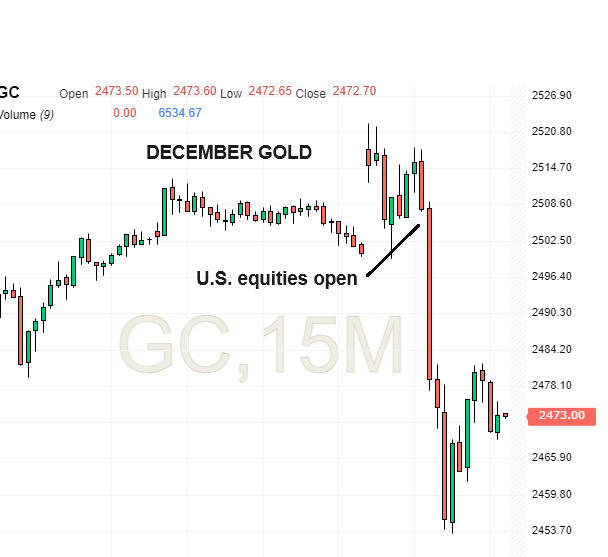
The gold market took off after the jobs report on Friday and soared to an all-time high of $2,522.30 (basis December futures) bit then took the queue from U.S. equities and proceeded to tank by $68.90 causing the gold bulls to scream "MANIPULATION" (followed by ten exclamation marks) when all that was really happening was that more of the same leverage used by the hedgies to juice Tesla stock had been applied to the SPDR Gold Shares ETF (GLD:NYSE).
It was as obvious as the noses on their heavily-perspiring faces because gold futures stayed "bid" up until just after equities opened at 9:30 and then boom! They took the GLD from the opening at $227.95 right up to $228.76, and then in a matter of minutes, the selling pressure took it straight down to $22.86, which in turn took the December futures into a nosedive with all this happening by 11:15.
What is good and great is that gold punched out to a new high for the futures above $2,500, and while it is perfectly normal to find overhead resistance at those round numbers, the demand for physical bullion continues to drive price, and with the Middle East heating up again, the geopolitical atmosphere is very gold-friendly right now.
The gold miners are kicking into gear with some blow-out earnings having been reported by not only the senior producers but also the mid-tier names like Alamos Gold Inc. (AGI:TSX; AGI:NYSE) that reported on Thursday and registered a 52-week high up 30% YTD.
The more I see these mid-tier and junior producers knock the cover off the ball, the more convinced I get of an impending upside response from the junior developers (like Getchell Gold Corp. (GTCH:CSE; GGLDF:OTCQB)) whose 2,059,900 ounces in Nevada are being valued at an absurd $9.60 per ounce.
When the average retailer decides that they had better steer clear of the meme stocks and/or the AI names, they will move rapidly to "where capital is being best treated," and that most certainly will be the gold and silver miners, which will include the developers who are outrageously cheap right now.
The one negative is that silver fails to keep pace with gold and the miners, and until I see the silver trade in September, which is freely above the 52-week high of $32.57, I will be mildly annoyed.
The missing link in this gold and gold miners' bull market is the ascension of silver to the role of leadership. You can still enjoy a brisk bull market in gold miners without the dominance of silver, but to generate the "there ain't no fever like gold fever"-style of mania, silver has to be the talk of the town or, as in the "old days," they have to be lined up at the now-defunct Scotia-Mocatta precious metals windows to buy silver, not gold. Then and only then will the junior gold and silver developers and explorers capture the kind of adoration and sponsorship of the speculator crowd who, up until now, have been infatuated with technology that will tie their shoes for them.
Copper
This week, I returned (albeit prematurely) to the rapturous position of being once again a shareholder in my absolute favorite stock for the decade — Freeport-McMoRan Inc. (FCX:NYSE) — which I pitched overboard a few months back when it punched out through $53.
With a 52-week high of $55.235, it touched $41.64 early Friday, putting it right in the middle of an accumulation zone I identified a month ago. Unfortunately, I started buying it back on Thursday before the jobs report route, so I am underwater, but I fully intend to add to my position late Friday or early next week.
Also catching my attention is Lundin Mining Corp. (LUN:TSX); LUNMF:OTCMKTS) (not to be confused with Lundin Gold) whose ownership of the Candelaria Mine has caught my attention. Forward guidance for 2024 has the mine known as an iron-oxide-copper-gold or "IOCG" deposit producing 160,000-170,000 tonnes of copper and 100,000-110,000 ounces for gold in 2024.
IOCG's are typically massive deposits, with the most notable being the Olympic Dam IOCG in West Australia, discovered by Western Mining in 1985. A junior that I have owned for over five years is Fitzroy Minerals Inc. (FTZ:TSX.V; FTZFF:OTCQB), which quite recently entered into an exclusivity agreement with Ptolemy Mining on a project located 45 km. SW of Candelaria which has the same suite of rocks that host Lundins's IOCG mine. Known to contain a substantial amount of economically viable copper-gold oxide mineralization, it is believed to be an early-stage IOCG with a geophysical footprint the size of Candelaria.
Fitzroy carries a market cap of a miniscule $11 million so with a September drill program planned and funded, the Buen Retiro IOCG project has earned the right to have my undivided attention and my cash.
The two metals that are perfectly-suited for today's global economic environment are copper and gold so this correction in the global markets gives me (and my subscribers) a chance to buy back FCX initiate new positions in LUN/LUNMF, and add to FTX/FTZFF.
As for the overall equity markets, chances are good that a shift in leadership is about to occur from the mega-cap tech stocks, but unlike the recent media-driven hypothesis that the rally is "broadening out" to include the Russell 2000 small-cap names, I would suggest that with over 40% of those falling into "Zombie" status with zero earnings and reliant on refinancing to survive, the rotation will not be into the Russell but into the cyclical names which includes the commodity producers where overvaluation has not been a serious dilemma since the 1970s and long overdue, especially for the copper-gold extractors and explorers.
| Want to be the first to know about interesting Silver, Gold, Base Metals and Critical Metals investment ideas? Sign up to receive the FREE Streetwise Reports' newsletter. | Subscribe |
Important Disclosures:
- As of the date of this article, officers and/or employees of Streetwise Reports LLC (including members of their household) own securities of Getchell Gold Corp. and Fitzroy Minerals Inc.
- Michael Ballanger: I, or members of my immediate household or family, own securities of: Getchell Gold Corp., Freeport-McMoRan Inc., Lundin Mining Corp., and Fitzroy Minerals Inc.. My company has a financial relationship with Fitzroy Minerals Inc. I determined which companies would be included in this article based on my research and understanding of the sector.
- Statements and opinions expressed are the opinions of the author and not of Streetwise Reports, Street Smart, or their officers. The author is wholly responsible for the accuracy of the statements. Streetwise Reports was not paid by the author to publish or syndicate this article. Streetwise Reports requires contributing authors to disclose any shareholdings in, or economic relationships with, companies that they write about. Any disclosures from the author can be found below. Streetwise Reports relies upon the authors to accurately provide this information and Streetwise Reports has no means of verifying its accuracy.
- This article does not constitute investment advice and is not a solicitation for any investment. Streetwise Reports does not render general or specific investment advice and the information on Streetwise Reports should not be considered a recommendation to buy or sell any security. Each reader is encouraged to consult with his or her personal financial adviser and perform their own comprehensive investment research. By opening this page, each reader accepts and agrees to Streetwise Reports' terms of use and full legal disclaimer. Streetwise Reports does not endorse or recommend the business, products, services or securities of any company.
For additional disclosures, please click here.
Michael Ballanger Disclosures
This letter makes no guarantee or warranty on the accuracy or completeness of the data provided. Nothing contained herein is intended or shall be deemed to be investment advice, implied or otherwise. This letter represents my views and replicates trades that I am making but nothing more than that. Always consult your registered advisor to assist you with your investments. I accept no liability for any loss arising from the use of the data contained on this letter. Options and junior mining stocks contain a high level of risk that may result in the loss of part or all invested capital and therefore are suitable for experienced and professional investors and traders only. One should be familiar with the risks involved in junior mining and options trading and we recommend consulting a financial adviser if you feel you do not understand the risks involved.






